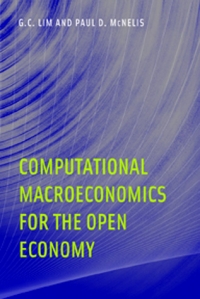Reviewed by
Domenico Delli Gatti
Istituto di teoria economica e metodi quantitativi, Università Cattolica del Sacro Cuore di Milano
 There are basically two strands of the literature on Computational Economics (CE). On the one hand, for many "unorthodox" people in this business CE means essentially Agent Based Modelling (ABM). In this case the spectacular increase in computational power over the last 20 years has been exploited to explore the role of agents' heterogeneity in a wide range of microeconomic and especially macroeconomic settings. Heterogeneity is a crucial issue that standard economic models simply can not tackle and which had been got rid of in a cavalier way by means of the infamous Representative Agent assumption. On the other hand, for the mainstream in the profession, CE means essentially numerical methods for the solution of Dynamic Stochastic General Equilibrium (DSGE) models. In this case the increase in computational power has been exploited to elaborate algorithms capable of finding solutions to fairly complex DSGE models.
The two-volumes Handbook of Computational Economics edited by L. Tesfatsion and K. Judd is a clear example of this division of labour in the field, one volume being devoted to ABM and the other devoted basically to numerical methods.
There are basically two strands of the literature on Computational Economics (CE). On the one hand, for many "unorthodox" people in this business CE means essentially Agent Based Modelling (ABM). In this case the spectacular increase in computational power over the last 20 years has been exploited to explore the role of agents' heterogeneity in a wide range of microeconomic and especially macroeconomic settings. Heterogeneity is a crucial issue that standard economic models simply can not tackle and which had been got rid of in a cavalier way by means of the infamous Representative Agent assumption. On the other hand, for the mainstream in the profession, CE means essentially numerical methods for the solution of Dynamic Stochastic General Equilibrium (DSGE) models. In this case the increase in computational power has been exploited to elaborate algorithms capable of finding solutions to fairly complex DSGE models.
The two-volumes Handbook of Computational Economics edited by L. Tesfatsion and K. Judd is a clear example of this division of labour in the field, one volume being devoted to ABM and the other devoted basically to numerical methods. The book by Lim and McNelis on Computational Macroeconomics belongs to the mainstream interpretation of CE. The issues at stake, therefore are not exactly those ones that the present (somehow unorthodox) writer would like to see at the centre of the research agenda in contemporary macroeconomics. Let me anticipate, however, that I like the book, for a couple of reasons, which I will discuss shortly.
A neat exposition of the basic aim of the book can be found in the very first page of the Preface: "The way toward more effective quantitative policy analysis is through the use of computational, stochastic non-linear (emphasis added) dynamic general equilibrium models. This study shows how such models may be made accessible and operational for confronting policy issues in highly open economies".
The book consists of 11 chapters. After the introduction, in chapter two the authors present a benchmark microfounded DSGE model with fully flexible prices in an open economy setting. The model presents the basic feature of any New Keynesian DSGE model, i.e., the important role of market imperfections due to monopolistic competition à la Dixit-Stiglitz. The complexity here comes from the explicit consideration of international trade. In particular, firms are supposed to use both labour and imported capital inputs to carry on production.
The following chapters add to complexity by introducing alternative variants of the benchmark model based on more realistic features. In chapter three, for instance the authors introduce nominal rigidity through Calvo contracts, another well known feature of NK-DSGE models. This of course increases the complexity of the model because firms cannot freely adjust their prices in case a shock occurs. Chapters from four to eleven introduce a number of realistic complications of the model: the public sector and fiscal policy issues (ch. 4), current account dynamics (ch. 5), the accumulation of physical capital (ch. 6), the role of natural resources (ch.7), financial frictions (ch. 8), wage rigidities (ch. 9), habit persistence (ch. 10), and international capital flows (ch. 11).
The book is very well written, extremely clear and very much oriented towards problem solving. Once one has accepted the basic tenets of the NK-DSGE model, this clarity of exposition and thorough treatment of the material is the main strength of the book.
A second remarkable feature of the book which could pass unnoticed but is worth emphasizing especially from a non-standard viewpoint is - in a nutshell - in that hyphenated word in bold above, non-linear, which qualifies the type of DSGE models the authors want to deal with. They state "it is no longer necessary to think linearly. For many years it was necessary to linearize the non-linear first order conditions of [DSGE] models around a long-run steady state in order to make these models operational for estimation ... While such linearization makes estimation and simulations relatively fast, it frequently throws out the baby with the bathwater, since many of the interesting questions in macroeconomic adjustment - such as asymmetric response of asset prices to shocks ... - necessitate explicit non-linear approaches" (p.xii). Non linearity therefore regains the place it certainly deserves also in DSGE macroeconomic modelling thanks to the increased computational power available to economists. This innovation should be welcome by those economists who have always emphasized the importance of non-linearity in macroeconomic dynamics and whose claim has been somehow superficially dismissed so far.
Return to Contents
of this issue
© Copyright Journal of Artificial Societies and Social Simulation, 2009